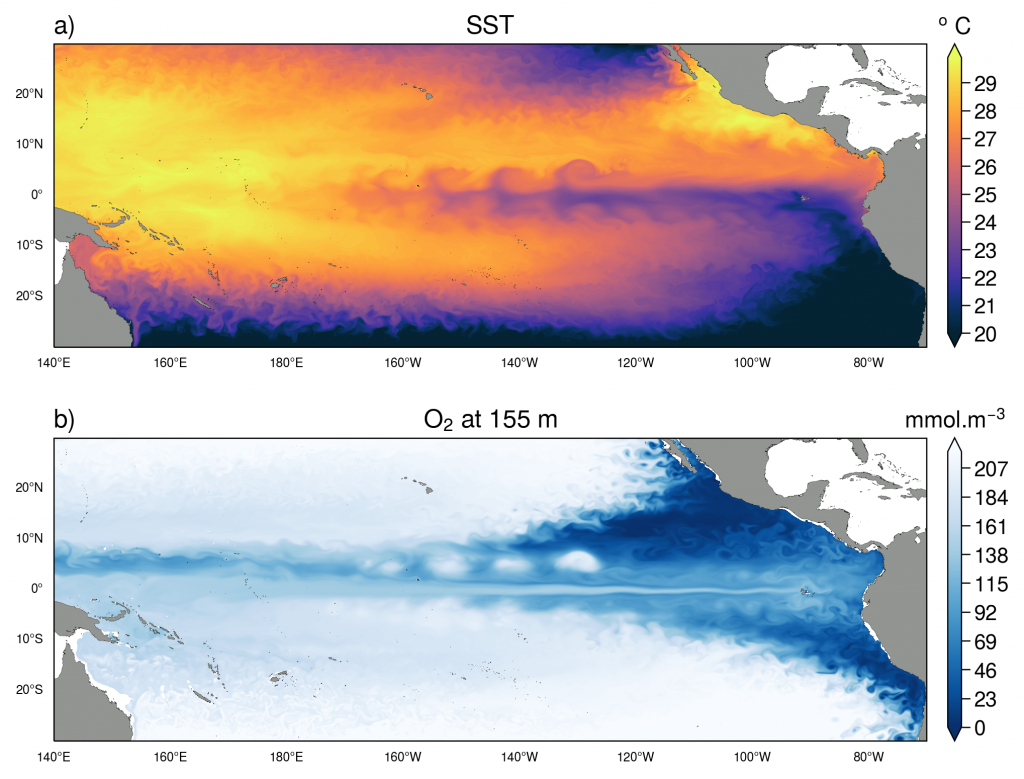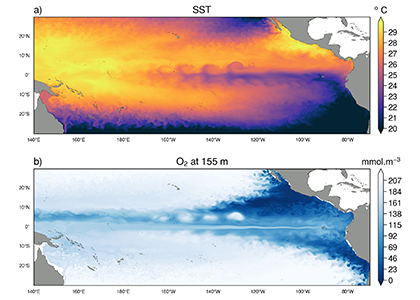As the ocean warms, the future of the tropical Pacific Oxygen Minimum Zones (OMZs) remains highly uncertain, in part due to incomplete understanding of processes and poor model representation of how mesoscale circulation impacts ocean biogeochemistry. To help address these gaps, a recent paper explored how mesoscale eddies modulate dissolved oxygen distributions and variability, with a particular focus on the upper northern equatorial Pacific where eddy kinetic energy is intensified.

Figure 1: Sea Surface Temperature (SST) and oxygen concentrations at 155 m depth in an eddy resolving simulation of CESM. Tropical Instability Vortices (TIVs) are outlined by cusp-like features in SST and oxygenated cores at depth.
The authors used an eddy resolving model simulation of the Community Earth System Model (CESM) and Lagrangian particle analysis to simulate the impacts of mesoscale eddies on oxygen distribution and variability in the upper equatorial Pacific Tropical Instability Vortices (TIVs)—large eddies associated with Tropical Instability Waves—lead to a substantial oxygenation of the upper equatorial Pacific. TIVs are generated from boreal summer through winter, and contribute to the seasonal oxygenation of the northern equatorial Pacific, exhibited as a seasonal shoaling and deepening of the northern eastern tropical Pacific OMZ. The processes governing the simulated TIV oxygenation of the upper equatorial Pacific are dominated by physical eddy advection and mixing, while biogeochemical feedbacks (e.g. enhanced microbial consumption of oxygen in the eddy cores) play a minor role. These simulated TIV oxygenation effects stand in contrast to the deoxygenation effects of Anticyclonic Mode Water Eddies recently observed and simulated along Eastern Boundary Upwelling Systems, suggesting a diverse and complex influence of mesoscale circulation on ocean biogeochemistry.
TIV influence on oxygen is highly relevant to predicting the variability and future of ecosystem habitable space, informing the source of model biases in this region, and guiding the current revamping of the Tropical Pacific Observing System, and should be explored in future observational campaigns.
Authors:
Yassir Eddebbar (Scripps UCSD)
Aneesh Subramanian (Colorado University, Boulder)
Daniel Whitt (NASA Ames Research Center)
Matthew Long (National Center for Atmospheric Research)
Ariane Verdy (Scripps UCSD)
Matthew Mazloff (Scripps UCSD)
Mark Merrifield (Scripps UCSD)




